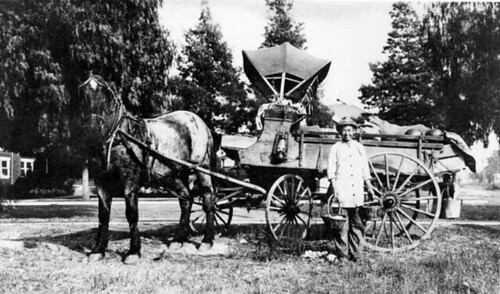
Each day at noon, the little children emerge from their classroom at the San Pedro-street school and tramp off to their respective homes to have a nutritious lunch en famille. Dear little creatures, some barely old enough to walk, who spend their days in learning what life is all about, and the skills they’ll need to navigate this fresh new city they are lucky enough to be citizens of.
On this particular day, the wee ones engaged in their favorite noontime activity, the tormenting of a Chinese vegetable peddler whose route regrettably takes him near to their school. The children fell upon his wagon, snatching up potatoes with which to pelt the… well, he was not a man, exactly, he was a Celestial, in the parlance of the day.
Enraged, the victim ran at the diminutive mob, waving his blacksnake whip and shrieking invective. What else could you expect from a savage? All the children scattered, save one terrified three-year-old boy. The vendor obligingly whipped the child about the head and the feet, compelling a passing white man to grab the whip and knock the Chinese to the ground. No one was badly hurt, and the parade moved on — just a typical happening in 1896 LA for all concerned.
Photo credit: Chan Yip Leung, a fruit and vegetable peddler next to wagon, 1914 (LAPL)


News reports about Chinese people around the turn of the century are fascinatingly racist. I came across a story about another Chinese vegetable peddler in a 1906 edition of the Oakland Tribune. It’s an interesting little vignette, but the real point of printing the story in the paper appears simply to have been to point out that Chinese immigrants talk funny. Most strange.
Anyway, here it is:
“WHITE BOYS WORK CHEAPER” SAYS SAM KEE
An Oakland lady relates the following story. By way of explanation, she deals with a Chinese vegetable peddler. Not one of the old sort, thank you, who takes his baskets from door to door and empties the contents on your kitchen steps for inspection, but a thoroughly up-to-date vegetable man with a sort of two story wagon bristling with red paint and compartments for his fruit.
This particular peddler rejoices in the name of Sam Kee, and if indications point to anything, he is on the straight road to wealth.
Several times in succession, according to the tale related by the lady, Sam made his appearance accompanied by a well-mannered, passably good looking American lad whose age might be anywhere from twelve to fourteen. It was the latter’s function to carry the purchases from the vegetable wagon, to the kitchen. This went on for several days.
Finally, one Saturday morning, when trade was very brisk, Sam came around to the door minus his young assistant. In the conversation which ensued, Sam enlightened his customer on many points reading the difficulty of securing efficient help. It started in this wise.
Mistress—”Where’s your helper this morning, Sam?”
Sam, resignedly—”I dunno, lady; he not come.”
“Why he not come, Sam?” inquired the lady in her very best pigeon English, acquired by long dealing with Chinese vendors.
Again came the noncommittal reply, accompanied by a decidedly Frenchy shrug of the shoulders: “I not know,
lady. I think he go work for somebody else.”
“Why you no get China boy go round with you?”
“Oh, China boy heap charge too much.”
The lady gasped. “China boy charge more than white boy?” she asked, when she’d recovered from the shock of the discovery that white boys underbid those from China.
“Heap more.” The tone of reply was strongly indicative of disgust. “White boy work for fifty cents a day.”
“And how much do China boys want?”
“One dollah, one half. Too much money for little boy.” Another shrug.
How’s that for cheap Mongolian labor?
The Chinese are quick enough to adopt American business habits, even if they don’t see the beauty of the Christian religion.